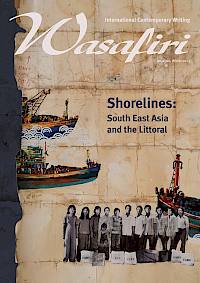Photo Essay: Changing Tides, Staying Grounded by Ilya Katrinnada and Jefree Salim
Joanne Leow, co-guest editor of our winter special issue, Wasafiri 116: Shorelines: South East Asia and the Littoral, with Nazry Bahrawi and Y-Dang Troeung, introduces this online-exclusive photo essay: ‘Curating art, literature, and scholarship about the littoral zones of Southeast Asia has been unavoidably political. This photo essay by Ilya Katrinnada and Jefree Salim offers a glimpse into Orang Seletar’s indigenous lifeworlds in the straits between Malaysia and Singapore. While Katrinnada provides much needed history and context to the photographs, Jefree’s work goes well beyond ethnography, as his interview with co-guest-editor Nazry Bahrawi suggests. Indigenous storytelling through his images allows for the voices of the Orang Seletar to be heard on their terms,’ she writes.
This issue focuses on a range of creative, critical, and artistic work from Singapore, Cambodia, Malaysia, Indonesia, Philippines, Vietnam, and Myanmar, and their diasporas. Purchase the print issue here.
On the southern coast of Johor Bahru lies a mound of sand. Sitting atop the Tebrau Straits, its peaks offer a panoramic view — with Danga Bay’s high-rise waterfront residences to the east and the Johor-Singapore Causeway further in the distance, Singapore’s Sungai Buloh to the south, a glimpse of the city of Johor Bahru to the north, and the small, quaint village of Kampung Sungai Temon situated a stone’s throw away to the west. When the sun rises in the morning, the mound’s shadows inch towards the village, symbolic of its encroachment into the land and waters that the villagers call theirs. While the man-made sand mound came to be only a decade ago, the Orang Seletar of Kampung Sungai Temon have been around for far longer.
For centuries, the Orang Seletar have called the Straits of Johor that separate mainland Singapore and the Malaysian peninsula, home. Historically a nomadic people, they used to roam, fish, and forage in the mangroves, shores, and rivers of the northern side of Singapore and the southern part of Malaysia in their pau kajang. The Orang Seletar spent much of their time on these houseboats, traditionally made of different types of mangrove wood and partially covered by a roof comprising of handwoven mengkuang leaves. On them, they slept, cooked, played, and rowed in search of sustenance. Periodically, they docked their pau kajang on the shores, and built bente, temporary villages of small pile-houses where the community could gather.
Today, nine Orang Seletar villages dot the southern coast of Johor Bahru, seven of which are located within a state-led development corridor, including Kampung Sungai Temon. Initial plans to move the villagers inland so as to make way for the corridor came to a standstill, leaving rows and rows of unplanned vegetation to flourish on the reclaimed sand mound. This began in 2012, when villagers of Kampung Sungai Temon and neighbouring village Kampung Bakar Batu filed a civil suit against developers, as well as the state and federal governments, leading to a decade-long legal battle to reclaim their right to remain on the disputed land and surrounding waters. Through oral history, they proved that their ancestors had been occupying these territories since at least the establishment of the Johor Sultanate in the sixteenth century, that they continue to have a strong connection with the contested environment, and that they still practise age-old customs passed down through the generations. In 2017, they were granted customary rights to their traditional lands and waters, and were entitled to monetary compensation. Still, the Orang Seletar appealled for ownership of the land. An agreement was reached in 2023, eleven years after the issue was first taken to court. Eighty-five families currently living in Kampung Sungai Temon will relocate to an area that is set to be gazetted as an Orang Asli reserve, thereby allowing them to sustain their lifestyle as fisherpeople. Construction of the new settlement, along with basic infrastructure and facilities, will be borne by a development company involved in the suit.
The aforementioned court case is but one example of how external forces and pressures have encroached upon the rights and welfare of the Orang Seletar. On the flipside, it sheds light on how they will stop at nothing to protect their land, waters, and the legacies of those who came before them. Among those walking this long road is Jefree Bin Salim — a fisherman by trade and a self-taught photographer by passion. For years, Jefree has been taking photographs of his people in various Orang Seletar villages. His images show how top-down processes such as land reclamation have brought about detrimental impact on the environment, livelihood, and well-being of his people; the zeitgeist of the Orang Seletar’s ever-changing tides. At the same time, they also capture the strength of an indigenous community in standing their ground and demanding a seat at the table, while providing a peek to the long-standing traditions of the Orang Seletar that remain today.
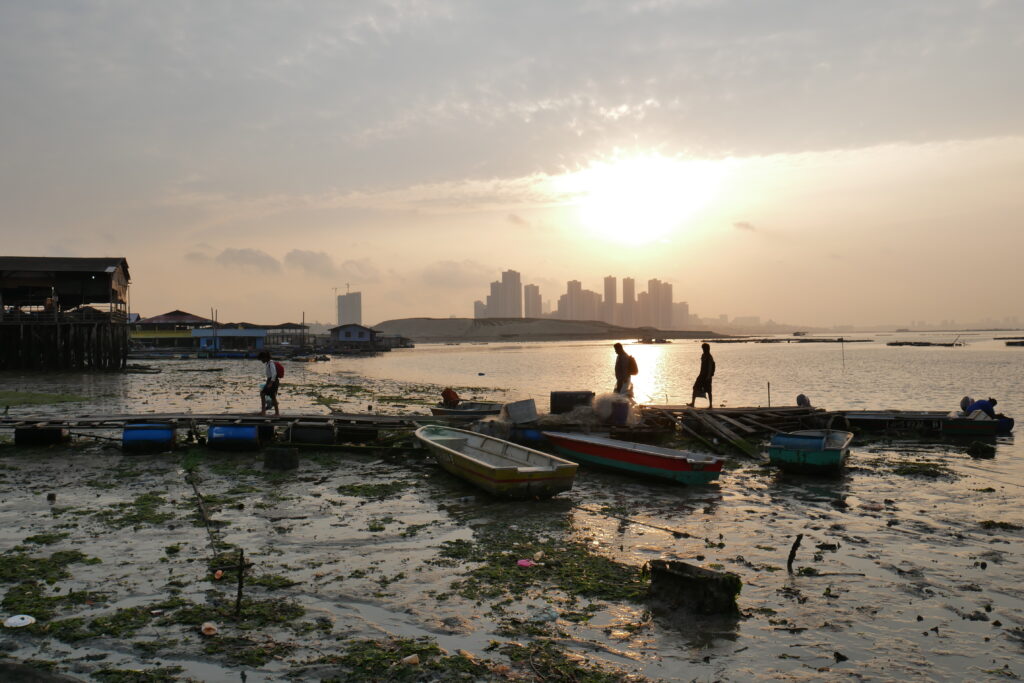
An early morning at Kampung Sungai Temon. Reclaimed land in the form of a sand mound stands in the background. High-rise waterfront residences can be seen further in the distance.
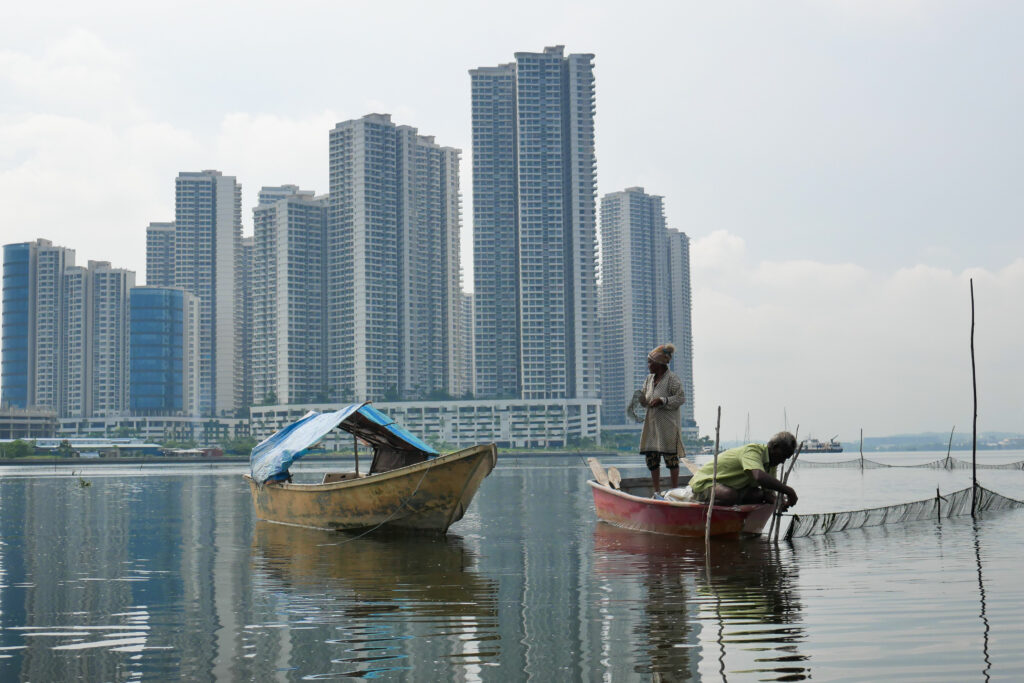
Near Kampung Bakar Batu, two fisherpeople find their catches for the day, a short distance from a waterfront living estate (background, left) and a sand-mining vessel (background, right).
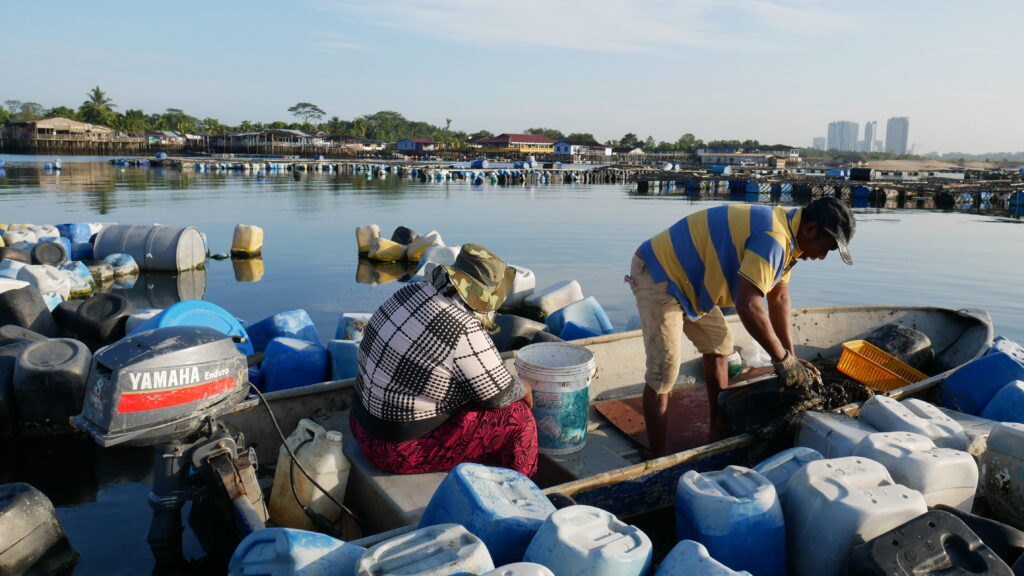
While the Orang Seletar traditionally fish, hunt, and forage for food, mussel farms like this one near Kampung Sungai Temon are now a common sight in Orang Seletar villages.
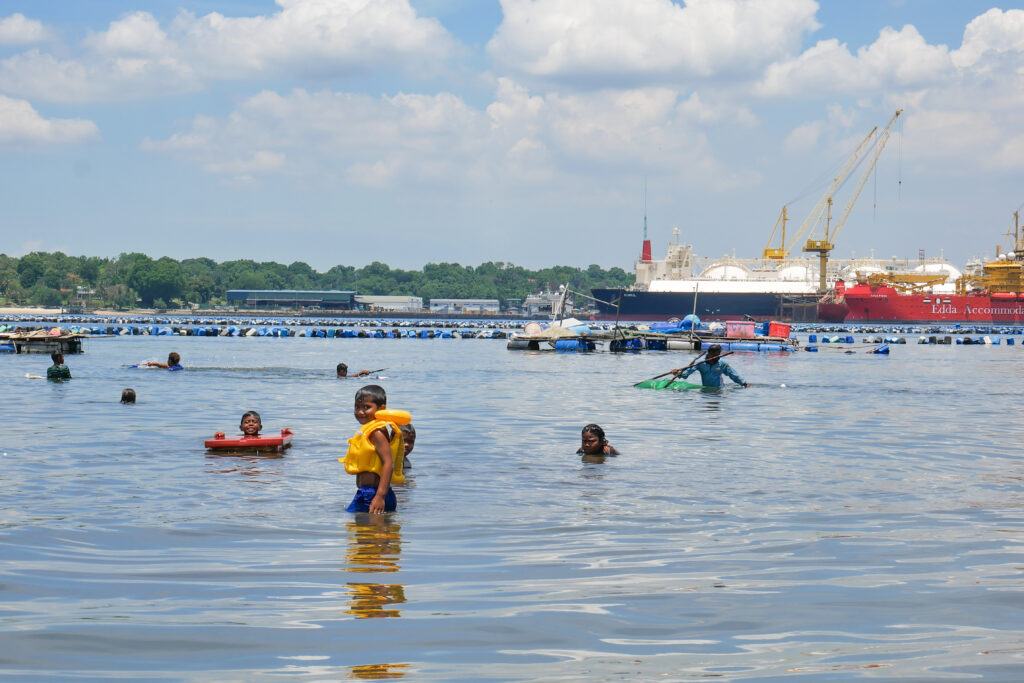
Kampung Teluk Jawa is located near the border between Singapore and Malaysia. Singaporean ships are an everyday sight for children who swim during low tide.
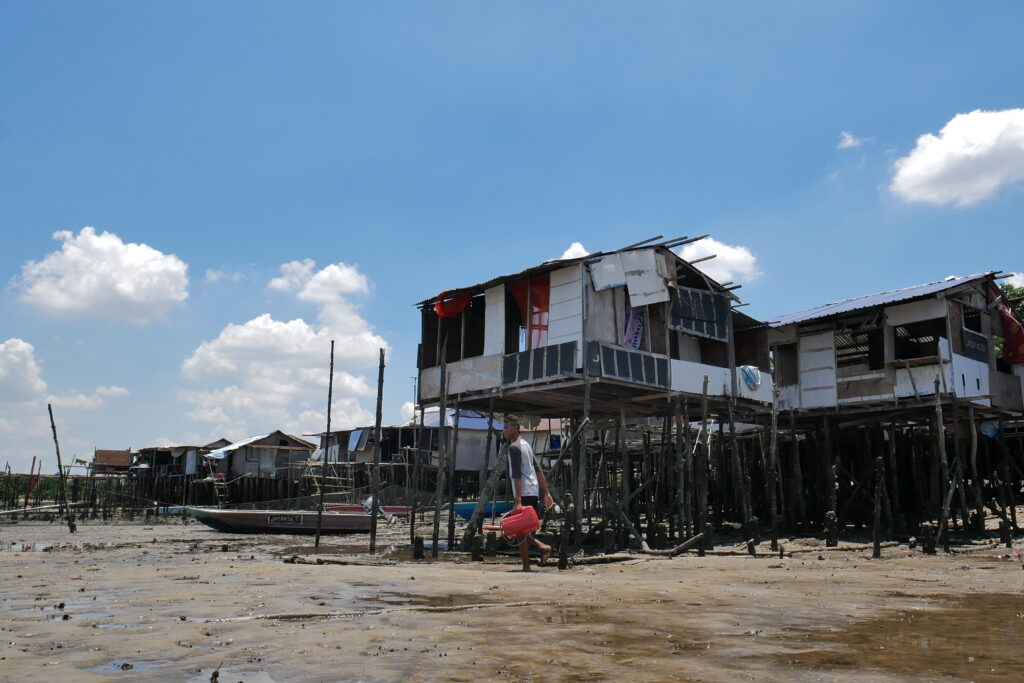
While some Orang Seletar now prefer to stay in houses on land, others live in wooden stilt houses by the waters, like these ones in Kampung Teluk Jawa.
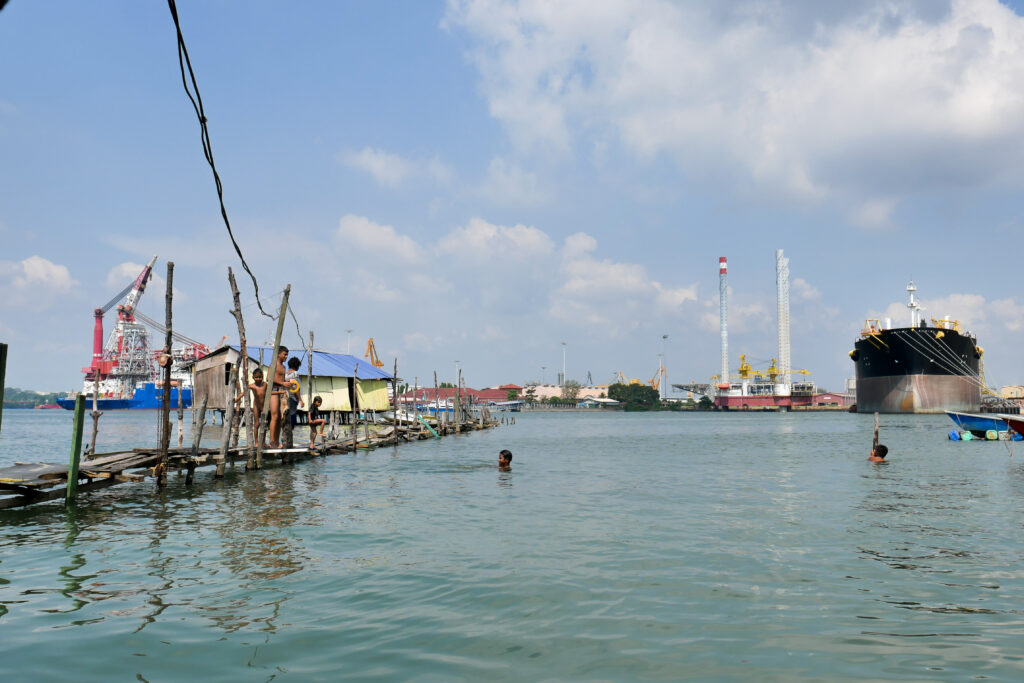
Located adjacent to a port, Kampung Pasir Putih has witnessed a dramatic drop in their seafood catches due to water pollution and oil spills.
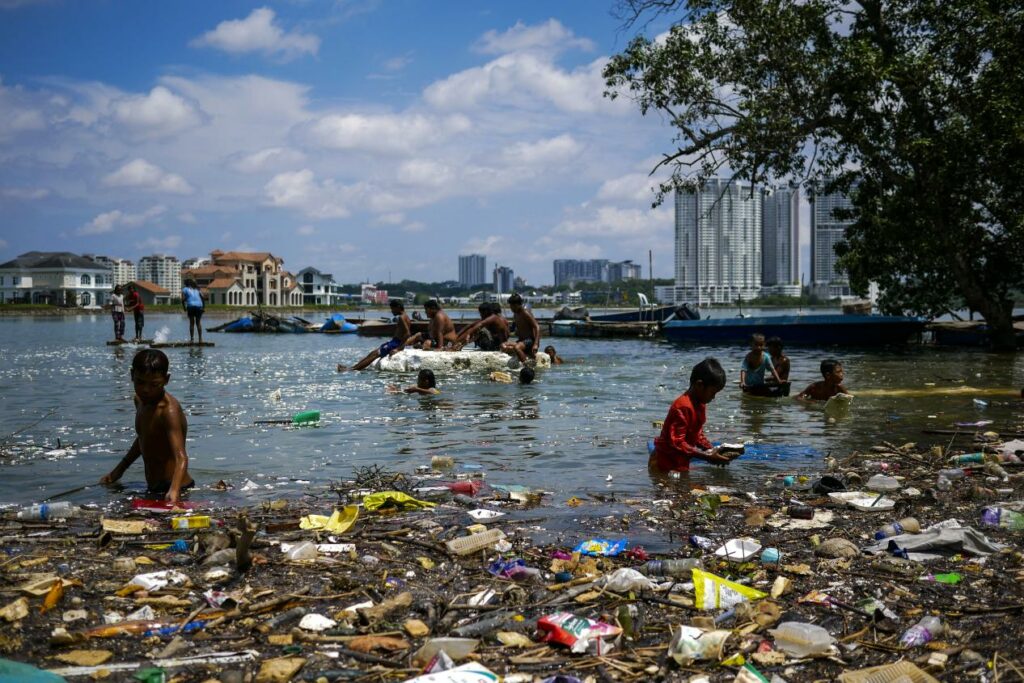
As villagers take a dip in the Skudai River, trash brought in by incoming tides inundates the waters’ edge.
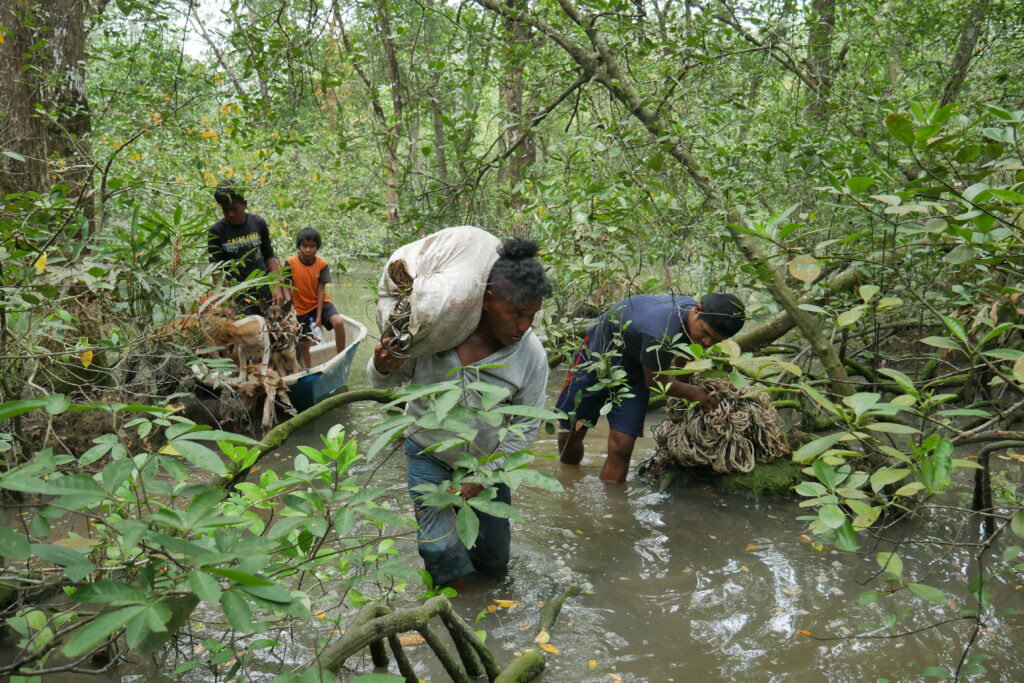
Besides seafood, the Orang Seletar also hunt for wild boars in the mangroves. Unfortunately, the size of mangrove forests surrounding their villages have shrunk over the years.
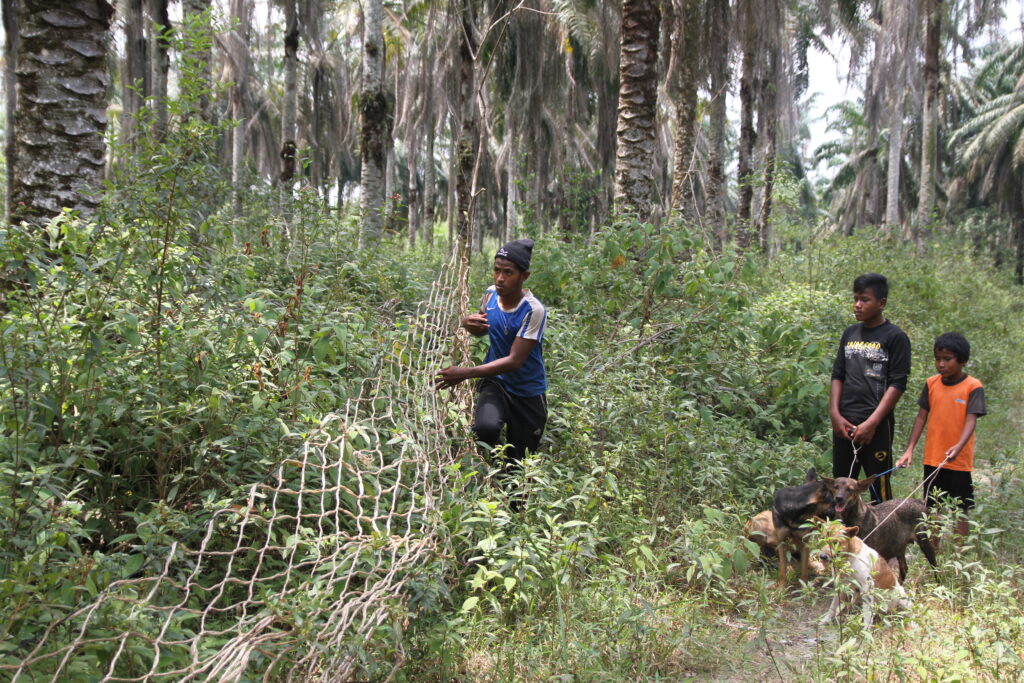
Orang Seletar are experts of mangrove ecology, which for centuries has provided them with food, medicine, and raw materials for daily necessities. Traditionally, the mangroves also act as burial sites.
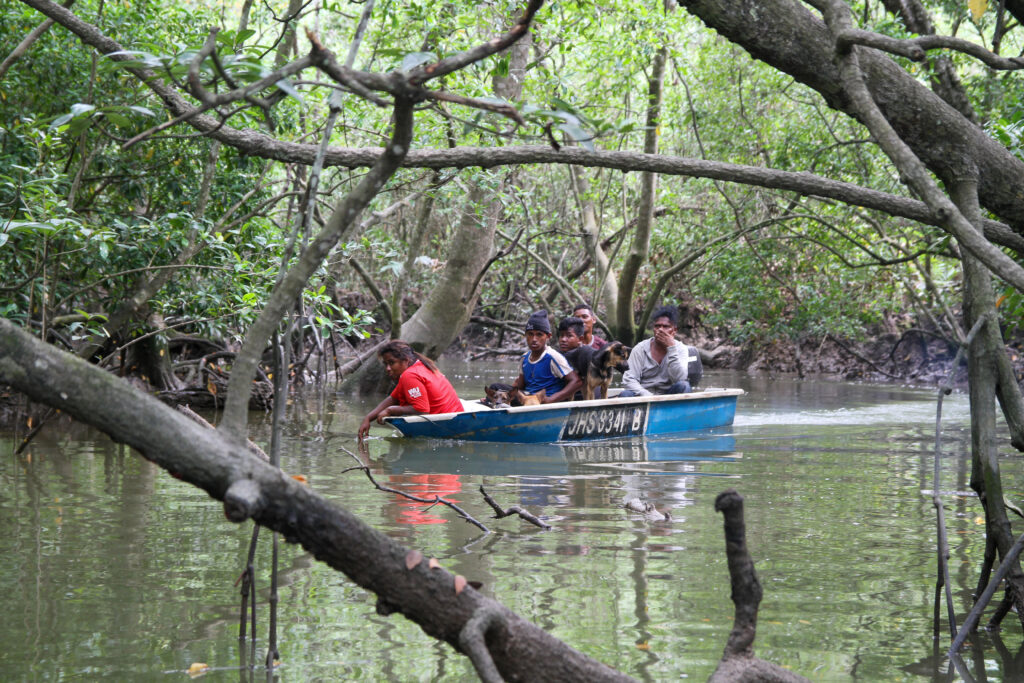
A popular spot to catch sea snails (siput gonggong), the coast near the Second Link bridge is frequented by Orang Seletar fisherpeople, and those from other communities. Turtles, dugongs, and seahorses are often spotted here.
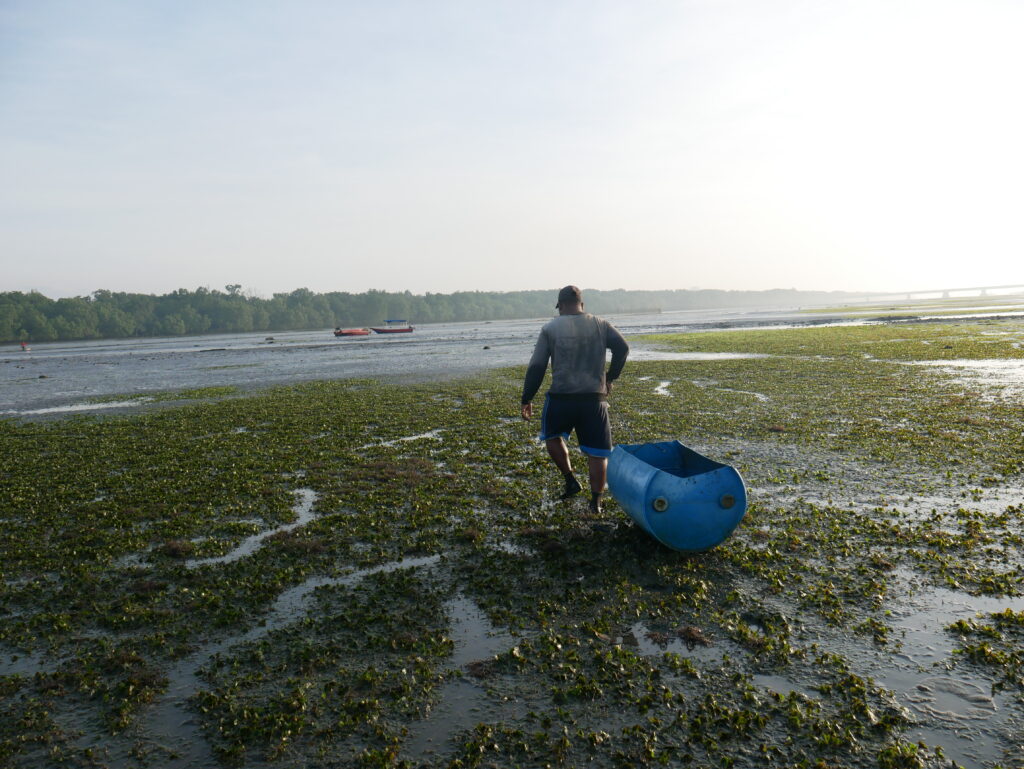
Dogs (angkook) are quite commonly spotted in Orang Seletar villages. The dogs sometimes follow fisherpeople out to sea, just as they used to in pau kajangs in the past.
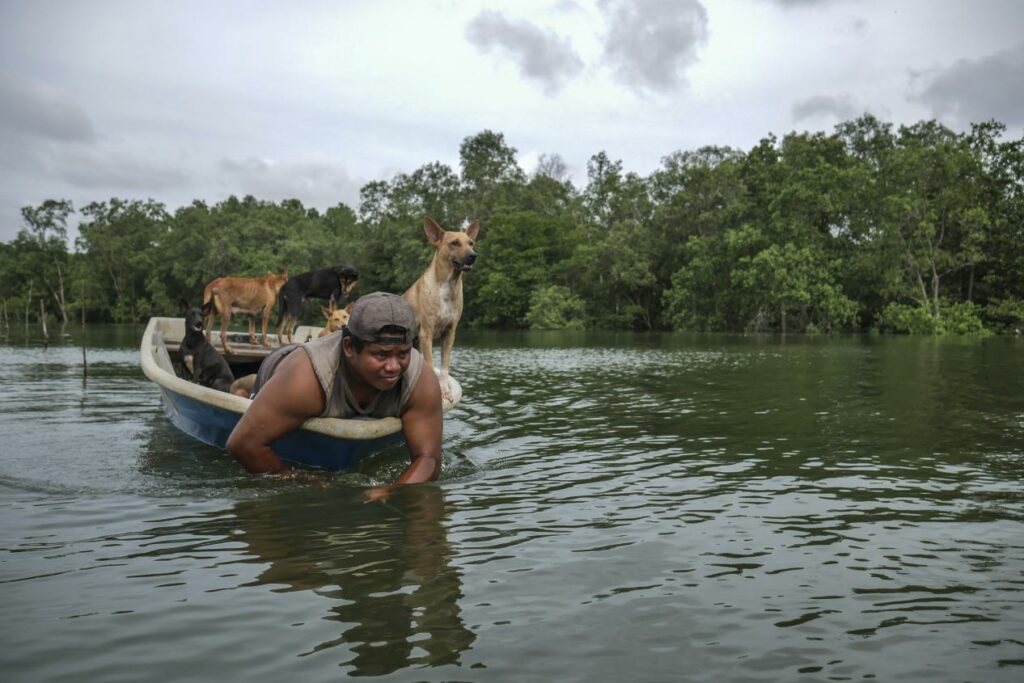
From the age of 10, the Orang Seletar learn to dive and use a spear to catch fishes. Skilled divers are able to hold their breath underwater for up to 8 minutes at a time.
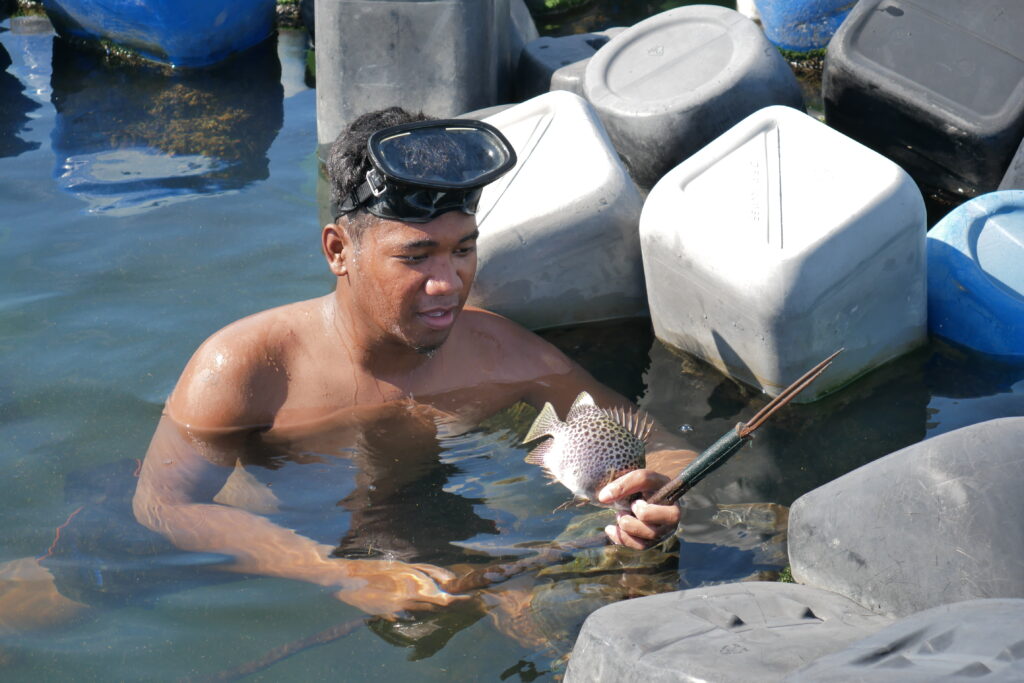
From a young age, Orang Seletar children are taught to acquaint themselves with the ways of the sea.
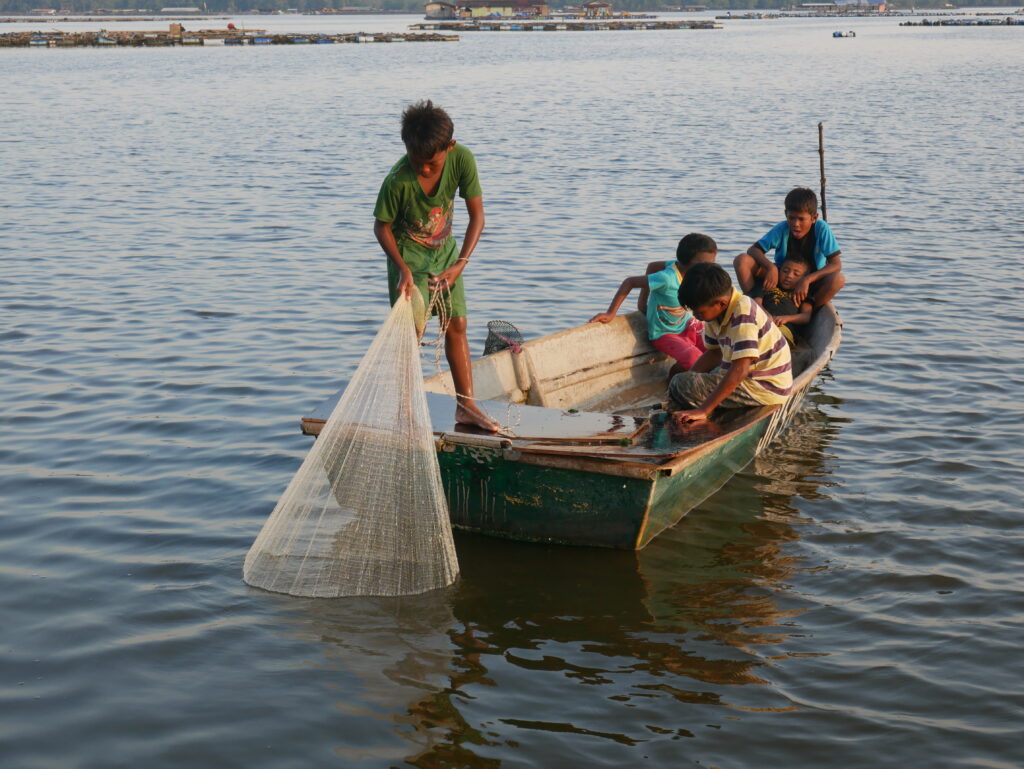
An Orang Seletar kid brims with joy as he shows off his catch.
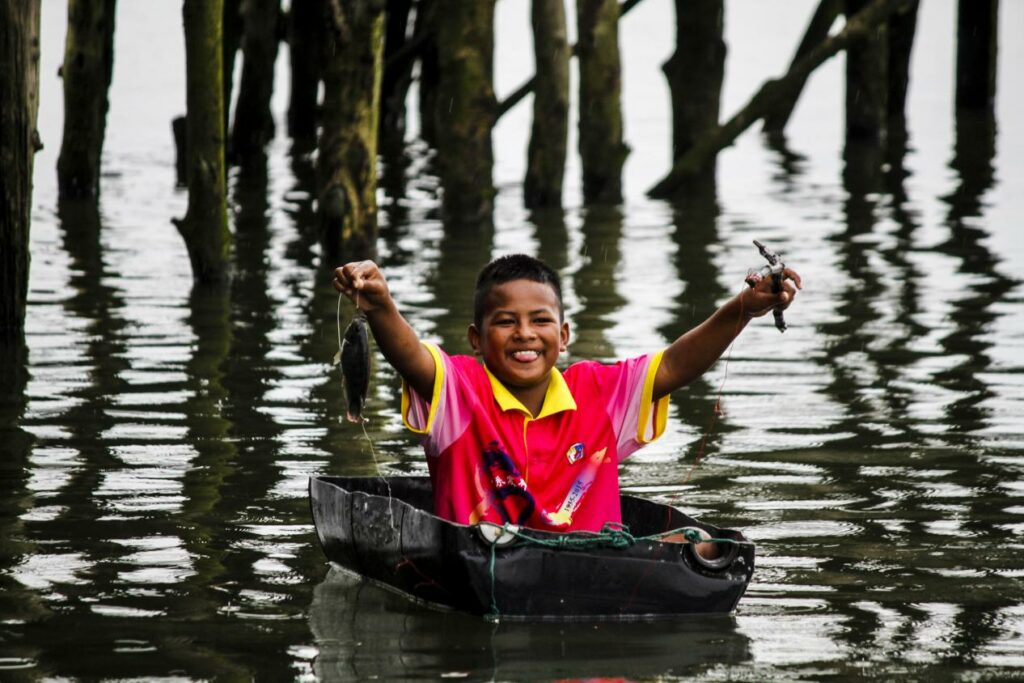
A group of Orang Seletar girls dressed in traditional wear. In the past, the Orang Seletar used to be invited by the Sultan of Johor to perform at special functions such as weddings. Today, they also carry out performances at events.
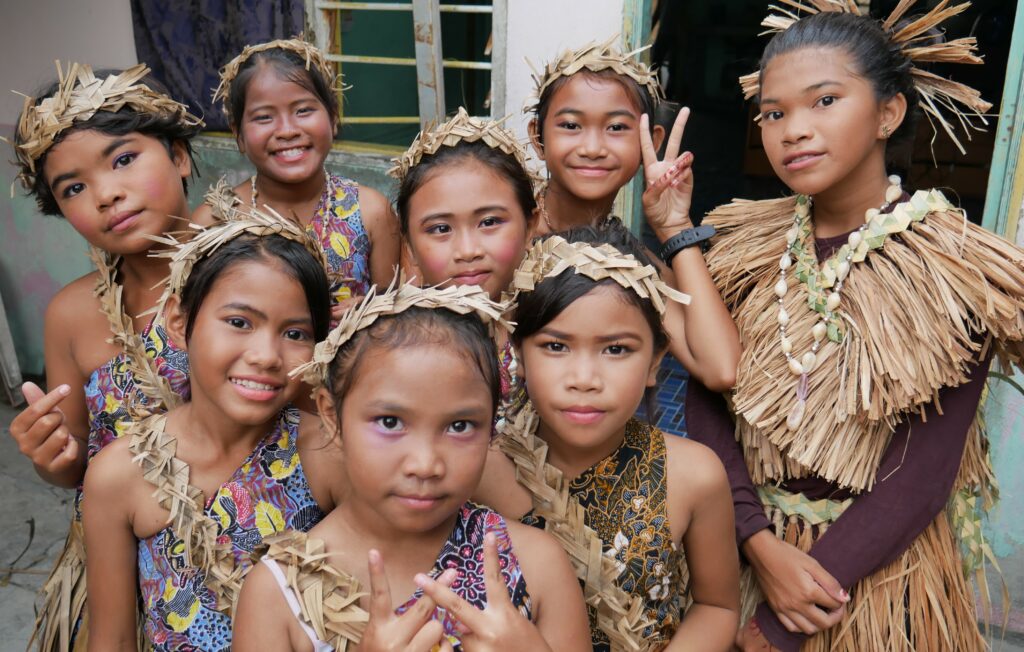
An Interview with Jefree Salim
Nazry Bahrawi for Wasafiri: Thank you for agreeing to this interview, Jefree. The Orang Seletar community of Johor is facing threats of eviction from their home. Some might say that political activism is the best way to draw attention to this issue, but photography is your medium of choice. Why this form to highlight the plight of your community?
Jefree Salim: Photography began as a hobby for me but then it became something more. Malaysia’s other ethnic groups – the Malays, Chinese and Indians – have got a lot of community members who are professionals in this field. The Orang Seletar community had none of their own who can professionally photograph and document the lives of our community. I was moved to master the craft so others can learn about the true conditions surrounding what are happening to our homes, to the jungles and mangrove swamps near our homes, and to record the pollution. Through photography, I hope that people would not just simply see my pictures as pictures but also take them to heart. I prefer photography to politics because it is more difficult to do the latter. Our people have registered our complaints officially. Yet the government is building skyscrapers where I live despite the pollution in our waters and the destruction of nearby mangrove swamps. Why is it that they would rather build these skyscrapers and not improve the living conditions of the Orang Seletar? Officials may think it is good for the people of Johor but it is not good for our community. And why must we be moved someplace further? Right now, we live in an area that is near amenities like a school, the hospital and the Johor city centre. We are getting relocated to a coastal area near Kota Tinggi, nearly two hours away from where we are. There, the main bridge that connects us to these amenities will be submerged at high tide or during a torrential downpour. How are we to send our children to school then? How are we to get to the hospital for medical emergencies like childbirth? We would need to wait till the water subsides in about two to three days. The piping system for clean water has not even been set up there. It has been decades.
Your photographs in this issue show strong contrast between tradition and modernity. I was particularly struck by the photo of the two fisherpeople at Kampung Bakar Batu taken with high-rise buildings and a sand-mining vessel in the background. Was this contrast something you had initially set out to portray or did it develop organically?
Photography began as a hobby for me. My philosophy for taking pictures is to capture the scene in its natural condition as best as I can. I often head out alone during these sessions and stop to observe members of my community going about their daily lives when I encounter them. The picture you mention features my cousin and my uncle netting prawns. The buildings in the background are Country Garden Danga Bay estate. Before the area to the picture’s left was filled with reclaimed land, the waters there were frequented by fisherpeople of all races. At low tide, you can catch mussels and catfish there. It has become much smaller now. As the area was getting reclaimed, you would notice about 30 to 40 barges carrying sand passing through. The ship in this picture is probably one of the remnant barges from those days. What you do not notice in this picture is that to the back of my vantage point lies a burial ground in the mangrove swamps for the Orang Seletar of a nearby village. It was disturbed when the swamps were getting cleared, which angered the villagers. So I prefer to be as naturalist as I can with my pictures, and not use models or props to stage a scene. It is time-consuming waiting to capture the right moment, and it could last days on end. I liken it to fishing. You go out to sea or the river and sometimes come back with a good load. Sometimes, there is just no single catch.
How would you respond to someone who say that your work is not art but anthropology?
I do not consider myself an artist nor do I think of my photography as art. The way I see it, I have a camera on me, and when I get the chance to snap a picture, I snap it. I am not concerned with people’s comments about the kind of photographer I am. For as long as I have a camera in my hand and get to pursue my hobby while drawing attention to my community, I will keep snapping. When I look at my pictures, I sometimes feel like weeping because of what is happening to our place. Each picture has a story that may be unknown to the viewer. But to me as the photographer, they hold a deeper meaning than simply a random image. The value of a picture to the viewer and the photographer can vary vastly. If you look at my Instagram page (@jefreesalim), you will find pictures of people from my community. I recall fondly snapping a picture of the late Nek Tina, a lovely elderly lady from our community who made me laugh. I was fascinated by her countenance which was why I snapped a portrait of her. She has since passed. That picture is poignant to me.
You have gestured to the close ties between the Orang Seletar and the Johor Sultanate with the picture of several young girls in traditional wear, ties that goes back all the way to the sixteenth century before the rise of nations. Can you tell us more about your thoughts about the history and evolution of the relationship? What does this picture signify to you?
Parts of the traditional clothes in this picture were made from tree barks. This has remained unchanged since the time of our ancestors who had served the Johor Sultanate at the height of its power in the seventeenth century. We do not want the younger generation to forget their adat (tradition). However, relations between our people and the Johor Sultanate have changed. Today, there is some contact between us, but it is no longer like the past when we were close. The elders of our community lament that the ties are now quite distanced. We only go for meetings about official business these days.
Both Malaysia and Singapore’s constitutions define a Malay as a Muslim. Both countries also widely accept that Malays and indigenous peoples like the Orang Seletar are native to the land, or bumiputera. Yet some of your photographs show the difference between these two groups: the hunt for babi hutan (wild boars) for food and burial near the mangrove swamps, both of which are not Islamic practices. Were you concerned that this might harm more than help the cause of saving the villages in terms of invoking sympathy from the majority Malay-Muslim community? What are your thoughts behind highlighting the difference between the Malays and Orang Seletar?
I am not worried because the Malays who fish and forage in the jungles are just as affected by pollution and urban development in recent years. Our yields are equally affected. For instance, we used to be able to get 20 to 30 kilograms of mussels per yield but now we are seeing that yield reduced to two to five kilograms. This is a notable reduction. Our collective fishing area has shrunk. We differ in terms of our techniques. Our people would study the landscape to understand the tide patterns: timing, direction, speed and such. We would then place our traps accordingly. There are also specific localities for crabs, prawns and fishes. These are skills that our people must master. Same goes for hunting wild boars. Our hunters will train dogs to specifically sniff out boars, so they would not confuse them with chickens, for instance. While some Orang Selatar members have converted to Christianity or Islam, there are many who have not and still practice adat. They bury their dead at the ancestral ground near the mangrove swamp, near Kampung Bakar Batu. They still practice hunting for wild boars even though the hunting areas have gotten smaller because our jungles have been cleared to make way for high-rise buildings.
Images © Jefree Salim
Wasafiri 116: Shorelines: South East Asia and the Littoral, our special winter issue guest edited by Nazry Bahrawi, Joanne Leow, and the late Y-Dang Troeung, features a range of creative, critical, and artistic work from Singapore, Cambodia, Malaysia, Indonesia, Philippines, Vietnam, and Myanmar and their diasporas, exploring the littoral encounter of existing on the shoreline.


